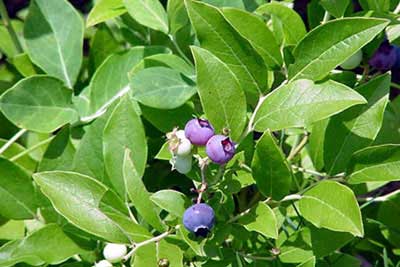Vaccinium corymbosum: Lowbush Blueberry
 Latin name: Vaccinium augustifolium
Latin name: Vaccinium augustifolium
Common name: Burgundy Wild Lowbush Blueberry
Flowers: White but inconspicuous16
Fruit: Small blue berries16
Height & Width: 2’ x 2’16
Type: Deciduous shrub16
Habit: Shrub16
Texture: Medium16
Growth rate: Moderate16
Light: Full sun to part shade16
Moisture: Medium16
Soil*: Medium
Zones: 5-916
Origin: North-eastern United States16
Features: The lowbush blueberry is a deciduous shrub that typically grows to about two feet high when preferences are met. They bloom in early spring with small white flowers. Edible blueberries will soon follow throughout the summer months that will attract students and wildlife alike. The leaves change to a red-purple during the fall and finally the stems turning red during the winter provides year round interest12.
Siting: Blueberries typically prefer medium to wet soils and are not drought tolerant. They are adapted to fine, medium, or coarse soils that have a pH range of 4.7 – 7.5. They should be planted in full sun although part shade is acceptable16.
Care: Plant crown at soil level18. At planting, water the roots and surrounding area slowly and deeply. Keep soil moist until plant is established, then apply enough water to thoroughly moisten the root zone when the soil is dry or during drought. Modify water recommendations to reflect site drainage and rainfall. Apply 3” of mulch over the planted area. Do not allow mulch to touch the plant stems18.
Pests: Plants are relatively pest resistant if cultural preferences are met.
Author: Alexander Smolka
Sources 1-18 found on Sources page
